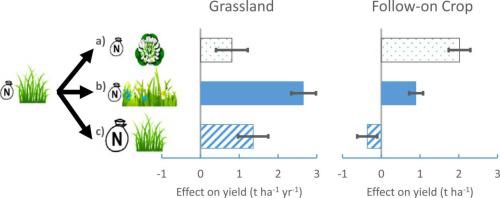European Journal of Agronomy ( IF 4.5 ) Pub Date : 2022-05-26 , DOI: 10.1016/j.eja.2022.126531 Guylain Grange , Caroline Brophy , John A. Finn

|
We investigated the degree to which plant species diversity, drought and fertiliser level in a grassland ley can affect performance of a follow-on crop in a rotation. Grassland species and functional group diversity (grasses, legumes and herbs) were manipulated from monocultures to six-species mixtures in the grassland ley phase. A simulated two-month summer drought treatment was compared to a ‘rainfed’ control. Plots received 150 kg ha−1 yr−1 of nitrogen (N) fertiliser; additional replicates of L. perenne monoculture received 300 kg ha−1 yr−1 of N fertiliser. After two years, grassland communities were terminated, and each plot reseeded with an Italian ryegrass (Lolium multiflorum) model crop; its yield indicated the relative legacy effect of the preceding treatments (plant diversity, drought, N input). There was a modest but constant negative effect of drought on dry matter (−0.36 ± 0.091 t ha−1) and nitrogen yield (DMY and NY respectively) of the subsequent crop of L. multiflorum, across all plant communities. There were strong differences among the identity effects of the six former grassland species on DMY and NY of L. multiflorum. Legume species had the strongest effects on DMY of L. multiflorum (6.09 t ha−1 for the former T. pratense monoculture and 6.54 t ha−1 for T. repens). The lowest crop yield was from the former low-diversity high-input replicates (4.16 t ha−1 for former L. perenne monoculture with 300 kg ha−1 yr−1). There was no evidence that interspecific interactions in the grassland phase affected yield of the follow-on crop. Thus, the legacy effect of grassland mixtures was estimated by the identities and proportions of the species sown in the mixture. Similar patterns were obtained for NY. High-diversity, low-input grassland yielded more DMY and NY than low-diversity, high-input grassland (across both ley and follow-on crop phases). However, a legume proportion in the grassland ley of at least 33% is required to achieve high forage and crop performance in a grassland-crop rotation.
中文翻译:

草地遗产对轮作后续作物产量的影响强烈受豆科植物比例影响,受干旱影响中等
我们调查了草地中植物物种多样性、干旱和肥料水平对轮作后续作物表现的影响程度。草原物种和功能组多样性(草、豆类和草本植物)在草地阶段从单一栽培转变为六种混合物。将模拟的两个月夏季干旱处理与“雨养”对照进行了比较。地块接受了 150 kg ha -1 yr -1氮肥;L. perenne单一栽培的其他复制品接受了 300 kg ha -1 yr -1的氮肥。两年后,草原群落被终止,每块地重新种植一株意大利黑麦草(Lolium multiflorum) 示范作物;它的产量表明了先前处理(植物多样性、干旱、氮输入)的相对遗留效应。在所有植物群落中,干旱对后来的何首乌作物的干物质(-0.36 ± 0.091 t ha -1)和氮产量(分别为 DMY 和 NY)有适度但持续的负面影响。6种原草地物种对何首乌DMY和NY的同一性效应存在较大差异。豆科植物对何首乌的 DMY 影响最大(以前的T. pratense单一栽培为6.09 t ha -1 , T. repens为6.54 t ha -1)。最低的作物产量来自之前的低多样性高投入重复(4.16 t ha -1之前的L. perenne单一栽培,300 kg ha -1 yr -1)。没有证据表明草地阶段的种间相互作用会影响后续作物的产量。因此,草地混合物的遗留效应是通过在混合物中播种的物种的特性和比例来估计的。纽约也获得了类似的模式。高多样性、低投入的草地比低多样性、高投入的草地(在麦田和后续作物阶段)产生更多的 DMY 和 NY。然而,在草地-作物轮作中,需要至少 33% 的草地豆类比例才能实现高草料和作物性能。











































 京公网安备 11010802027423号
京公网安备 11010802027423号